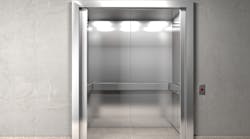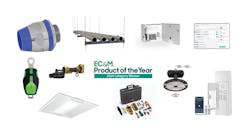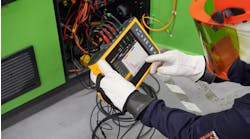Elevators are sensitive and complicated machines. When damage and downtime occur, the owner can quickly be faced with a substantial repair bill.
A wide range of power quality issues can affect elevator equipment. Historically, older motor-generator powered elevators were well isolated from voltage sags and swells. Since the alternating current (AC) motor was spinning, the direct current (DC) generator inertia of the rotating stator and armature continued to spin through the sag or swell. However, elevator modernization has increased the sensitivity to power quality events by replacing the motor-generator set with AC-DC adjustable speed drives (ASDs). In addition to being sensitive to power quality events, all ASDs are prone to misoperate when improperly wired, bonded, and grounded.
Can you identify the problem in the two photos below?
This problem was identified when investigating misoperations of a modernized elevator with ASDs. The metal gutter raceway connects the new ASDs to the DC overhead traction motors of the hoistway. When the new ASDs were installed, a ground was required by the manufacturer to provide a stable voltage to the power electronics. The elevator installer then connected a ground wire to the fire sprinkler pipe, attempting to establish a ground connection in the building. The electrical feed to the elevator room from the main service was only 480V, 3-wire, with no ground.
Lacking understanding of grounding and bonding per the National Electrical Code (NEC) will lead to problems similar to this example. A debated subject of grounding and bonding is the requirement for fire sprinkler piping to be bonded to the grounding electrode system (GES) of the building per NEC Sec. 250.52. Fire sprinkler piping is not intended to serve as part of the primary GES; however, the authority having jurisdiction (AHJ) may require it to be bonded per NEC Sec. 250.104.
The fire sprinkler piping in the photo is threaded and electrically continuous until it drops down the far wall to a pipe fitting. Some pipe fittings isolate the piping sections, especially at the main building entrance. This isolation at the building entrance helps to protect the cathodically protected underground piping from AC current flow. Essentially, for this case, the fire sprinkler was not bonded to the GES. An electrical contractor should have been hired to ensure the building steel is connected to the GES and then use an exothermic connection to the building steel in the elevator room to ensure a solid connection to the GES. This solid connection will stabilize the ASD, reducing misoperations and elevator downtime.




